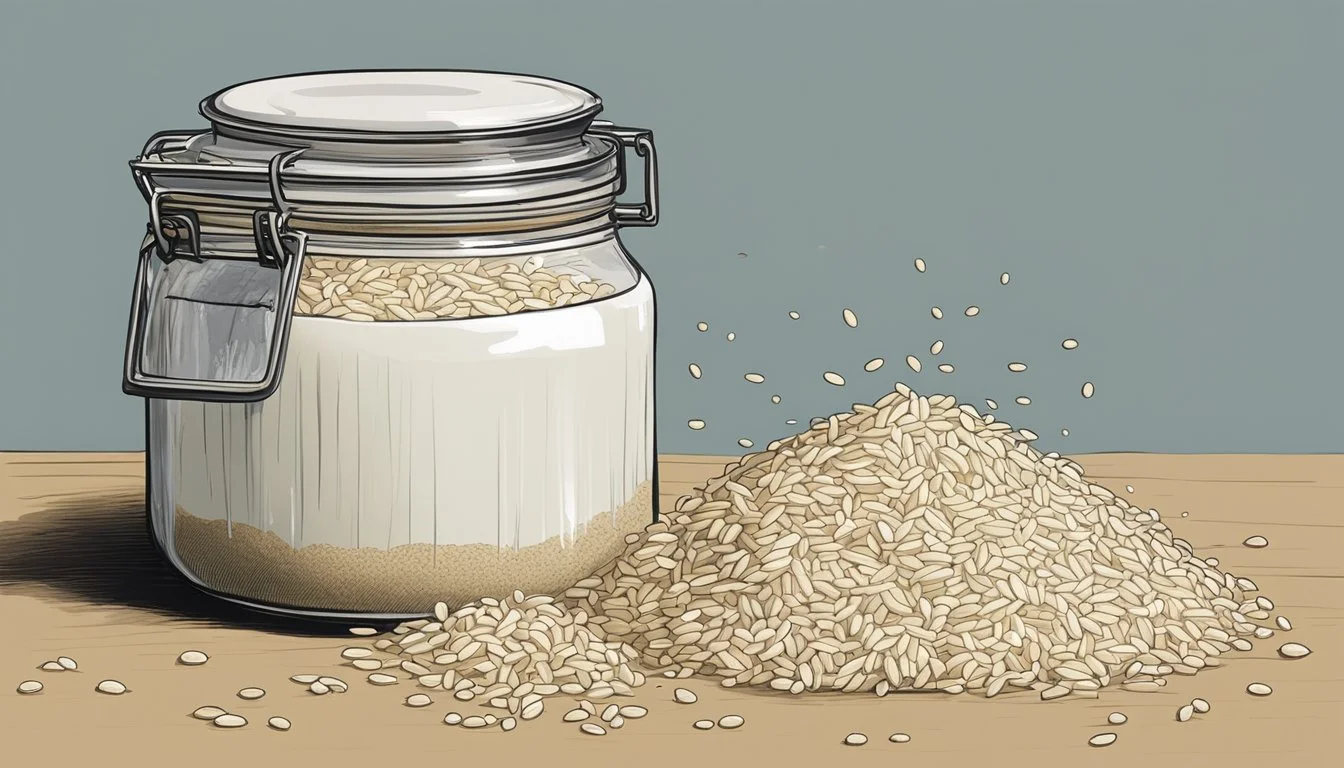How to Ferment Huangjiu
Mastering Traditional Chinese Rice Wine Techniques
Huangjiu, also known as Chinese rice wine, is a traditional beverage that captures the essence of ancient fermentation techniques, and has been an integral part of Chinese culture for millennia. The process of fermenting rice into this aromatic wine is both an art and a science, involving a series of meticulously executed steps. The flavor compounds which endow Huangjiu with its distinct taste and fragrance are a result of the complex interplay between the ingredients used and the microbial activities during the fermentation process.
The initial phase in creating Huangjiu involves selecting quality glutinous rice, which is then methodically cleaned, soaked, and steamed to precise specifications. This preparation is crucial as it sets the foundation for successful fermentation. The introduction of Qu, a Chinese fermentation starter comprised of various molds, yeasts, and bacteria, initiates the transformation of the rice's starches into sugars, and eventually, into alcohol. Throughout this fermentation process, the environment is carefully controlled to ensure the resulting wine develops the desired flavors and aromas that are characteristic of Huangjiu.
Understanding the nuances of Huangjiu production is key to appreciating the depth and variety it offers. Enzymatic activity during fermentation not only affects efficiency but also plays a pivotal role in flavor development. This microbial symphony creates a multitude of metabolites, contributing to the unique aroma and taste profiles of each Huangjiu variation. As techniques and palates have evolved over time, so has the diversity of this storied beverage, solidifying its place in both tradition and modern culinary practice.
History and Cultural Significance
Huangjiu, a traditional Chinese rice wine, is interwoven with the historical tapestry of China's culinary and cultural practices. Its inception dates back over 5,000 years, positioning it as a beverage with ancient origins and significant cultural value.
This wine, often encompassing varying names and techniques across regions, is best exemplified by Shaoxing Huangjiu, a famed variant that hails from Shaoxing, a city renowned for its wine production in the Zhejiang province. The iconic status of Shaoxing Huangjiu is attributed to its quality and adherence to traditional brewing methods, which have been preserved across generations.
The brewing process of Huangjiu is a meticulous fusion of cereal grains, yeast, and Qu—a saccharification agent similar to the "koji" used in Japanese sake production. The saccharification and fermentation are critical steps that bestow Huangjiu with its unique and desirable flavor profile, one that has captured the palates of connoisseurs for centuries.
In Chinese society, Huangjiu is not merely a beverage; it represents a culinary tradition reflective of China's agrarian roots and the ingenuity in utilizing local agriculture for sophisticated gastronomy. It frequently graces tables during festivals, is a staple in celebrations, and serves as a warm welcome to guests—exemplifying its role as a symbol of hospitality and joy.
The significance of Huangjiu to Chinese culture is further evidenced by its inclusion in historic literary works and its revered status amongst emperors and commoners alike, marking it as a beverage that traverses social stratifications. The enduring legacy of Huangjiu in China is a testament to its importance as a cultural and historical artifact.
Raw Materials and Preparation
The creation of Huangjiu hinges on the meticulous selection of grains and preparation of starter cultures. The quality of rice and the fermentation process are pivotal to the final flavor profile of the wine.
Choosing the Rice Variety
Glutinous rice, known for its high amylopectin content and low protein and fat, is the preferred choice for brewing Huangjiu due to its ability to become sticky when cooked. This quality is essential for the fermentation process. However, some brewers opt for japonica rice which can impart a lighter flavor and increase the concentration of amino acids in the final product.
Production of Starter Culture
The starter culture, known as Qu, is a mix of mold such as Aspergillus and Rhizopus, along with lactic acid bacteria like Lactobacillus and Bacillus. These microorganisms are crucial for converting the starches in rice to sugars and then to alcohol. They are typically grown on a grain base and formed into bricks or balls before being mixed with the main batch of rice.
Rice Cooking and Cooling
Rice used in Huangjiu production must be thoroughly cooked to ensure optimal starch gelatinization for fermentation. The cooked rice needs to be cooled down quickly to a suitable temperature that will allow the microbes in the starter culture to thrive without being killed by excessive heat. This step is critical to ensure a successful fermentation process, leading to the development of the wine's distinct aroma and flavor.
Fermentation Process
The fermentation process of Huangjiu involves the careful inoculation of starter culture, maintaining specific environmental conditions, and closely monitoring the progress to ensure the desired outcome. This well-orchestrated sequence enables microorganisms to convert sugars into alcohol, producing a wine with a unique aroma and flavor.
Starter Culture Inoculation
At the outset, starter cultures containing Aspergillus or other molds, yeasts, and lactic acid bacteria are sprinkled into steamed rice to initiate fermentation. This microbial community, known as Qu, is the cornerstone of Huangjiu's fermentation, as it breaks down the complex carbohydrates into simpler sugars that yeast can ferment.
Environmental Conditions
The success of fermentation hinges on maintaining optimal environmental conditions:
Temperature: The fermentation setting is usually kept at a warm temperature, typically between 25°C to 30°C (77°F to 86°F), to foster the proper growth and activity of the microorganisms.
Moisture: Adequate moisture is essential for proper mold growth and enzyme activity, which is why the rice requires a precise water content level.
Aeration: Proper oxygenation is needed for aerobic microorganisms to prosper, especially during the early stages of fermentation.
Monitoring the Progress
Monitoring is done frequently to ensure that:
The alcohol content is rising as the yeast ferment the sugars.
The presence of compounds such as estase and ethyl carbamate is monitored, as they can influence both flavor and safety profiles of the wine.
By keeping a careful watch on the levels of these and other metabolites, brewers can adjust the fermentation parameters to produce Huangjiu with the desired characteristics.
Microbiology of Huangjiu
The fermentation of Huangjiu relies on a symbiotic relationship between yeast and bacteria. Microbial communities evolve throughout the process, influencing the flavor profile and quality of the final product.
Role of Yeast and Bacteria
Huangjiu fermentation begins with the inoculation of a yeast starter, typically composed of Saccharomyces cerevisiae, in conjunction with a variety of bacteria, including species of lactic acid bacteria (LAB). These microorganisms are essential as they convert sugars into alcohol and organic acids. Saccharomyces primarily drives the alcoholic fermentation, while LABs, such as Lactobacillus, contribute to the acidic profile, increasing the complexity of the wine's flavor. Bacteria such as Acetobacter and Gluconobacter can further influence the taste by producing acetic acid and other aromatic compounds.
Microbial Community Dynamics
During the fermentation process, there is a dynamic succession of microbial communities. Early stages are often dominated by Saccharomyces and various LABs. As fermentation progresses, Wickerhamomyces, Saccharomycopsis, and other aroma-producing microorganisms become more prevalent. This shift is a result of the changing environment within the fermenting medium, such as alterations in pH, nutrient availability, and alcohol concentration. Advanced techniques, such as high-throughput sequencing, have allowed for a better understanding of these microbial communities and their roles. The presence of flavor-active microorganisms is critical, as they produce a multitude of metabolites that define Huangjiu's unique sensory characteristics. The exact composition of the microbiome and the bacterial succession over time are directly correlated with the distinctive flavor and aroma profiles characterizing Chinese rice wine.
Chemistry of Flavor and Aroma
The rich and complex flavors of Huangjiu are the result of intricate chemical reactions during fermentation, yielding an array of flavor compounds and a distinctive aroma profile.
Formation of Flavor Compounds
The fermentation of Chinese rice wine, Huangjiu, produces a diverse spectrum of flavor compounds, including esters, alcohols, ketones, aldehydes, phenols, acids, and tannins. These compounds arise from the metabolic activities of various microorganisms present during the fermentation process.
Esters: Formed by the reaction between alcohols and acids, esters contribute to the fruity and floral notes in Huangjiu. Ethyl esters, in particular, impart a pleasant bouquet and are essential for the wine’s overall flavor.
Alcohols: Besides ethanol, other alcohols like methanol, add complexity and depth to the flavor.
Aldehydes and Ketones: These compounds can provide a range of aromas from fresh, green notes to more pungent, undesirable ones, which must be carefully managed.
Phenols: They add to the wine's aroma complexity and can contribute to feelings of astringency due to tannin content.
Acids and Tannins: Organic acids, such as tartaric and malic acid, influence the sourness and stability of the wine, while tannins are known to add bitterness and astringency.
Analytical techniques, like gas chromatography–mass spectrometry (GC-MS) and high-performance liquid chromatography (HPLC), are essential for identifying the presence and concentration of these volatile flavor compounds. Additionally, multivariate statistical analysis and gene sequencing of the microbial populations offer insights into the complex interplay that governs flavor formation.
Analysis of Aroma Profile
Understanding the aroma profile of Huangjiu involves identifying volatile aroma compounds responsible for the wine's nose. The typical aroma of Huangjiu is characterized by a blend of various volatile compounds that contribute to its multi-layered fragrance.
Volatile Flavor Compounds: A wide range of volatile compounds, such as esters, alcohols, and acids, combine to create the signature aroma of Huangjiu.
Organic Acids and Reducing Sugars: These contribute not only to the taste but also to the aroma, often providing a balancing act between sweetness, sourness, and the alcoholic warmth of the rice wine.
Instruments like GC-MS play a pivotal role in separating and identifying these compounds. Such technologies enable the detection of minute quantities of aroma constituents, enhancing our comprehension of their impact on sensory perception. The interplay of these volatile components gives rise to Huangjiu’s distinctive flavor characteristics that are revered in traditional Chinese culture.
Sensory Profile
The sensory profile of Huangjiu is a rich tapestry that includes both gustatory (taste) and olfactory (smell) experiences, with intricate nuances that contribute to its overall flavor quality.
Characterizing Taste and Smell
Huangjiu's taste profile is complex, often characterized by a balance of sweetness, derived from the fermentable sugars, and sourness, resulting from organic acids produced during fermentation. These two primary tastes are accompanied by a refreshing acidity, contributing to the wine's crisp profile. Additionally, Huangjiu may present a slight astringency due to tannin content, alongside a bitter aftertaste which can add depth to its flavor.
The olfactory sensation of Huangjiu is marked by an aromatic spectrum that includes hints of fruit and esters, which are responsible for floral and fruity notes. Alkanes also feature in Huangjiu's aromatic profile, producing an alcoholic fragrance that is mellowed during the aging process. The presence of esterase within the microbiome helps in breaking down these esters to further refine the wine's aroma.
Influence on Overall Flavor Quality
Several components impact the overall flavor quality of Huangjiu, with biogenic amines playing a crucial role in imparting a full-bodied umami taste, which is considered the hallmark of a high-quality fermented product. The intricate balance of sweet, sour, and umami is sometimes accompanied by the savoriness of sauce-like flavors, enhancing the beverage's complexity.
Moreover, the production of esters, influenced by the Huangjiu microbiome, notably contributes to the wine's unique and refreshing fruity aromas. A well-crafted Huangjiu with optimal acid and ester balance can yield an overall flavor quality that is mellow and rich, but also fresh and invigorating. Through the art of fermentation, brewers carefully control the introduction of these elements to achieve a distinct sensory profile rarefied in the world of fermented beverages.
Quality Control and Safety Measures
Huangjiu, known for its distinct aroma and flavor, requires meticulous quality control and safety measures to ensure a superior product. Producers must enforce standardized production protocols and routinely test for hazardous compounds.
Standardization of Production
Quality control in Huangjiu production begins with standardizing each step to ensure consistency. Manufacturers should adopt:
Good Manufacturing Practices (GMP) to maintain hygiene and prevent contamination.
Standard operating procedures (SOPs) for each stage of fermentation, detailing specific temperature, humidity, and timing parameters.
Continuous monitoring of microbial activity to control the fermentation environment and influence the Huangjiu's unique flavor profile.
Sensory evaluation methods, including taste and smell assessments, to gauge the presence of desired metabolites that contribute to the aroma and taste.
Detection of Hazardous Compounds
To safeguard consumer health, rigorous testing for hazardous compounds is pivotal. Key compounds to monitor include:
Ethyl Carbamate: A potential carcinogen formed naturally during fermentation.
Set strict limits and regularly test using gas chromatography-mass spectrometry (GC-MS).
Biogenic Amines: Result from the breakdown of amino acids by bacteria, high levels can cause adverse health effects.
Employ High-Performance Liquid Chromatography (HPLC) for accurate measurement.
Other contaminants (e.g., heavy metals, mycotoxins).
Utilize relevant toxicological assays to detect and quantify.
Ensuring the safety and quality of Huangjiu is critical to maintaining its status as a cherished sweet rice wine and protecting public health.
Modern Fermentation Technology
The advent of modern fermentation technology has significantly advanced the production of Huangjiu. The process utilizes starter cultures that have been optimized through biotechnological methods to ensure consistency and enhance the quality of the wine.
Starter Cultures: In contemporary practices, saccharification and fermentation occur concurrently, and the role of starter cultures is pivotal. These cultures are a complex assembly of various microorganisms, which include, but are not limited to, yeasts, molds, and bacteria.
Yeasts: Convert sugars into alcohol and carbon dioxide.
Molds: Break down starches into fermentable sugars.
Bacteria: Contribute to the flavor and aroma profile.
Gene Sequencing: With the assistance of gene sequencing technologies, producers can analyze and select specific strains of yeast and other microorganisms that are most conducive to producing desired flavors. This detailed genetic understanding ensures a carefully controlled fermentation process.
Technology: Gene Sequencing, Benefit: Tailored selection of microbial strains
Technology: Fermentation Tanks, Benefit: Precise temperature and environment control
Technology: Sensor Technology, Benefit: Real-time monitoring of fermentation parameters
Techniques such as automated pH control and the use of fermentation tanks allow for a highly controlled environment, where parameters such as temperature and acidity can be adjusted to affect the final taste of Huangjiu.
By integrating sensor technology, fermentation processes are constantly monitored, enabling rapid responses to any deviations from the optimal conditions. In turn, this maintains the integrity of the flavor profile during each batch of production.
Pairing and Culinary Uses
Huangjiu, the traditional Chinese rice wine, is a versatile beverage that enhances a range of culinary experiences. Its unique umami quality makes it an excellent pairing for a variety of dishes.
Seafood and Poultry: For lighter proteins such as seafood and poultry, huangjiu's milder varieties complement the delicate flavors. The wine's subtle sweetness balances the oceanic salinity of seafood and the savory notes of chicken.
Red Meat and Game: Robust versions of huangjiu can stand up to the strong flavors of red meat and game. The depth and intensity of older, more concentrated rice wines enrich the taste of these hearty dishes.
Vegetarian Dishes (What wine goes well with vegetarian dishes?): Vegetables stir-fried or braised can be elevated with a splash of huangjiu, increasing complexity with its aromatic profile.
In terms of culinary uses, chefs employ huangjiu in various ways:
Marinades: As a marinade, huangjiu tenderizes meat and infuses it with flavor.
Braising Liquids: Added to braising liquids, it imparts an additional layer of taste.
Sauces and Glazes: Reduced down, huangjiu becomes a rich sauce or glaze, perfect for finishing dishes.
Use Case: Marinades, Effect on Dish: Tenderizes, adds complex flavors
Use Case: Braising Liquids, Effect on Dish: Enhances depth, introduces subtle sweetness
Use Case: Sauces/Glazes, Effect on Dish: Creates rich, aromatic accompaniments to dishes
When cooking with huangjiu, chefs should consider its alcohol content; cooking evaporates most of the alcohol, leaving behind the desired aromas and flavors. It's a testament to the culinary versatility of huangjiu that it finds such broad use across the spectrum of Chinese gastronomy.








